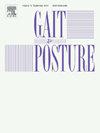Children with and without relapsed clubfoot show task-specific deviations in lower limb kinematics during several dynamic activities compared to typically developing children
IF 2.2
3区 医学
Q3 NEUROSCIENCES
引用次数: 0
Abstract
Background
The occurrence and the treatment of a relapsed clubfoot is a challenge in clubfoot care. Early recognition of relapse is important to minimize the invasiveness of treatment and its impact on foot functionality later in life. Gaining insight into a child's functional performance during various challenging activities will provide a comprehensive understanding of treatment outcomes which might result in crucial information for identifying relapse indicators.
Research question
This study aims to identify kinematic differences during dynamic activities between relapsed and non-relapsed Ponseti-treated clubfoot patients, and typically developing children.
Methods
Movement analysis, including the Helen Hayes model extended with the Oxford Foot model, was performed in 56 children; 14 relapsed clubfoot, 21 non-relapsed clubfoot and 21 age-matched TDC. Differences in lower extremity kinematics during walking, toe walking, heel walking and running were analyzed using statistical parametric mapping.
Results
Compared to walking, more demanding activities accentuated task-specific deviations in children with clubfoot, such as limited plantar flexion during toe walking and decreased knee flexion during running. Children with relapsed clubfoot showed kinematic deviations in all three planes of motion across all four activities, compared with children with non-relapsed clubfoot or TDC. Differences are observed at the foot and the pelvis, as well as in the hip and knee joints.
Significance
More demanding dynamic activities aid in distinguishing between relapsed and non-relapsed clubfoot, by revealing task-specific deviations. Furthermore, our findings suggest that clinical assessment of clubfoot should include attention to compensations rather than only focusing on foot-specific characteristics.
与正常发育的儿童相比,有或没有复发性内翻足的儿童在一些动态活动中表现出下肢运动学的任务特异性偏差
背景:复发性内翻足的发生和治疗是内翻足护理的一个挑战。早期识别复发对于减少治疗的侵入性及其对以后生活足功能的影响非常重要。深入了解儿童在各种具有挑战性的活动中的功能表现将提供对治疗结果的全面了解,这可能为确定复发指标提供关键信息。研究问题本研究旨在确定复发和非复发庞塞蒂治疗的内翻足患者以及典型发育中的儿童在动态活动中的运动学差异。方法对56例儿童进行运动分析,包括Helen Hayes模型和Oxford Foot模型的扩展;复发性内翻足14例,非复发性内翻足21例,年龄匹配的TDC 21例。采用统计参数映射法分析了行走、脚趾行走、脚跟行走和跑步时下肢运动学的差异。结果与步行相比,高要求的活动加重了内翻足儿童的任务特异性偏差,如脚趾行走时足底屈曲受限,跑步时膝关节屈曲减少。与未复发内翻足或TDC的儿童相比,复发内翻足的儿童在所有四项活动中都表现出三个运动平面的运动学偏差。在足部和骨盆以及髋关节和膝关节处观察到差异。通过揭示任务特异性偏差,要求更多的动态活动有助于区分复发性和非复发性内翻足。此外,我们的研究结果表明,畸形足的临床评估应包括对代偿的关注,而不仅仅是关注足的特异性特征。
本文章由计算机程序翻译,如有差异,请以英文原文为准。
求助全文
约1分钟内获得全文
求助全文
来源期刊

Gait & posture
医学-神经科学
CiteScore
4.70
自引率
12.50%
发文量
616
审稿时长
6 months
期刊介绍:
Gait & Posture is a vehicle for the publication of up-to-date basic and clinical research on all aspects of locomotion and balance.
The topics covered include: Techniques for the measurement of gait and posture, and the standardization of results presentation; Studies of normal and pathological gait; Treatment of gait and postural abnormalities; Biomechanical and theoretical approaches to gait and posture; Mathematical models of joint and muscle mechanics; Neurological and musculoskeletal function in gait and posture; The evolution of upright posture and bipedal locomotion; Adaptations of carrying loads, walking on uneven surfaces, climbing stairs etc; spinal biomechanics only if they are directly related to gait and/or posture and are of general interest to our readers; The effect of aging and development on gait and posture; Psychological and cultural aspects of gait; Patient education.
 求助内容:
求助内容: 应助结果提醒方式:
应助结果提醒方式:


